
Presbyopia is the natural loss of focusing ability that accompanies aging. This condition can be corrected with contacts, glasses, or surgery.
Introduction to Presbyopia
As we grow older the lens of the eye becomes much more rigid, hindering the ability to properly focus light onto the retina. This condition, presbyopia, affects approximately two billion people worldwide. Though not lethal or painful, presbyopia results in the inability to focus on close-up objects, and studies have found that the condition negatively affects quality of life. Presbyopia is irreversible, but there is a few options to correct the vision effects. These include eyeglasses, contact lenses, or surgery in some cases.
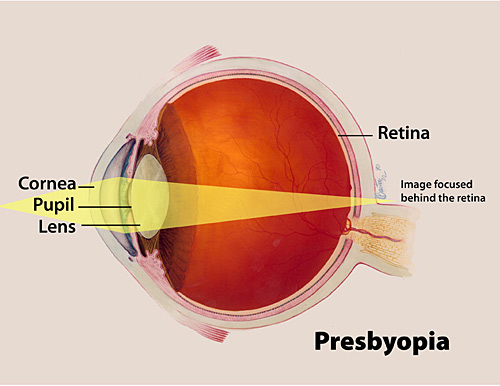
Adaptive presbyopia-correcting solutions work to restore auto-focusing abilities to the crystalline lens. Courtesy of National Eye Institute
What Are the Options for Presbyopia Correction?
Progressive addition lenses (PALs) are the most common solution for presbyopia patients. These lenses have a vertical gradient of increasing power such that the wearer can see at all distances by peering through different parts of the lens. They eliminate the need for multiple pairs of single-vision glasses and the vision “jump” associated with bifocal or trifocal lenses. PALs, however, do not work for everyone. The lenses are very sensitive to mounting errors, they cannot be prescribed for eyes with considerable refractive error difference, and they restrict field-of-vision.
The best way to address presbyopia is to mimic the auto-focusing process of the crystalline lens – a feat which requires an adaptive system. Researchers have proposed many variable-focused technologies for adaptive eyeglasses including fluid-filled lenses and liquid crystal lenses. These methods, however, are not ideal for presbyopia correction. Focusing unpolarized light often requires stacking lenses to account for both E-field directions, thereby creating bulky glasses that are difficult to adjust. Liquid crystal lenses also require a diffractive lens to bend light which decreases contrast and causes lens flares.
A team with Laclarée Vision in France proposed their novel presbyopia-correcting adaptive doublet lens in an article of Optics Express. Their paper presents a comprehensive review of their method that includes summarizing specifications, compliance with eyeglass requirements, prototype discussion, and future improvements.
The Concept of Presbyopia Correction
The Laclarée team defines six requirements for presbyopia-correcting adaptive lenses:
1. Addition- The lenses must provide effectively increased power for near vision.
2. Static Correction- The lenses must be able to correct static spherocylindrical refractive errors of the eyes.
3. Focusing Response- The research team writes that the focusing response should be continuous, automatic, and as fast as it was before presbyopia effects set in. This response time should be fast enough for safe and comfortable vision, but cannot be so fast that it causes magnification distortion.
4. Field-of-Vision- The lenses must provide comfortable vision at both near and far distances.
5. Optical Quality- The lenses must have high transmission and adequate wavefront correction for the best possible optical quality.
6. Aesthetics/Portability- The research team did not want their design to stick out among other eyeglass options. They should be similar in both volume and shape while remaining lightweight for simple portability.
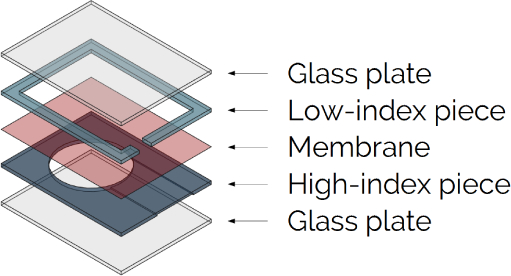
The solid structure for the variable-focus lens. Courtesy of Optics Express
The Lens Design
The research team wanted their design to improve upon the aesthetics, ergonomics, and portability of standard variable fluid-filled lenses. Their approach includes a four-layer lens. The two middle layers provide power addition and variable focus. The doublet includes two layers of fluid separated by an ultra-thin membrane; one fluid layer has a low refractive index while the other has a high index. Deforming the membrane changes the volume ratio between the two fluids, thereby changing the optical power of the lens. The lens shape is easily malleable because the inner layers feature channels that carry fluid from the actuation system (discussed below) to the variable zone. The design also allows the lens to be either plano or curved. Two external layers supply the static correction and any necessary lens treatments.
The Actuation System
The actuator of the variable-focus system relies on the film that separates the two fluids. The film is in a gap between two grid electrodes such that applying a voltage difference moves it toward one of the electrodes. This motion sweeps fluid between the film and electrode off the microfluidic pump while the other fluid fills the displaced volume. The actuator can generate negative or positive pressure differentials since the film can move toward either electrode depending on the applied voltage.
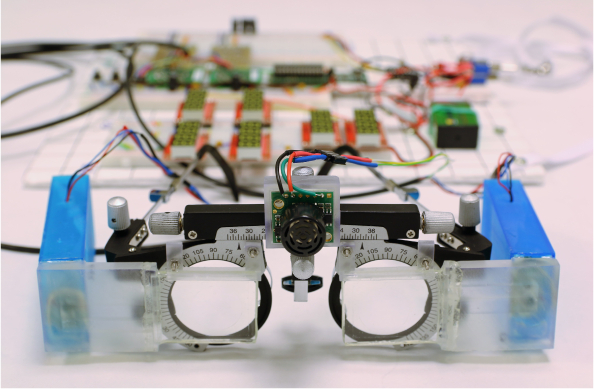
The Laclarée team’s presbyopia-correcting prototype equipped with plano lenses. Courtesy of Optics Express
The Presbyopia-Correcting Eyeglass Prototype
The Laclarée research team assembled a portable prototype to test their design and seek further improvements. The prototype consists of one opto-fluidic engine for each eye, a distance sensor to measure focusing distance, and a control system to drive the engines. The sensor first determines the distance so that the control system can calculate the necessary voltage to apply to each actuator. The prototype features plano lenses which are not common for ophthalmic purposes. This provides the researchers a baseline from which they can compare with benefits of the curved lens.
The Discussion
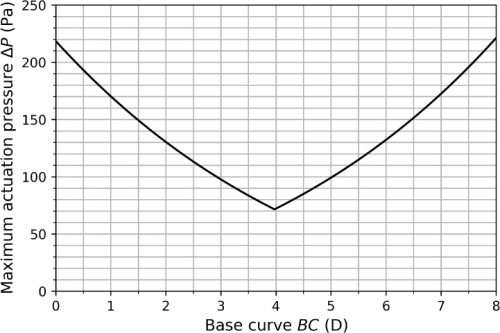
Maximum actuation pressure over different base curve values. Courtesy of Optics Express
Actuation Pressure and Applied Voltage
The actuation pressure range only spans positive values (about 0-200Pa) when the lens is in the plano configuration. Operating the lens in the curved configuration allows the researchers to take advantage of the full pressure range which provides both negative and positive differential pressures. This profile therefore provides much better electrical consumption efficiency when compared to the plano lens. In addition, the team shows that the curved lens consumes much less power to achieve the same optical response. Their results show the maximum requested voltage of the lens should be about 80V, therefore consuming about 25mW of power.
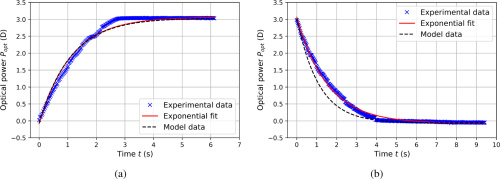
Dynamic power response in the curved configuration for ascending (a) and descending (b) transitions. Courtesy of Optics Express
Response Time
The team then used the optimal curved configuration to test the lens response time for transitions from near to far vision (ascent) and from far to near vision (descent). These measurements were acquired with a noticeably high applied voltage of 140V, so we can expect a significantly faster response time when compared with the desired max of 80V. Response times for the ascending and descending transitions were 2.3s and 3.4s, respectively. These times, the research team concedes, are likely a little too long for comfortable vision. They write that they hope to achieve a 1s response time by using a less viscous fluid and adjusting the design for the lens channels and actuator.
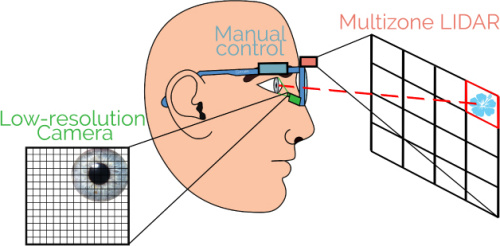
The proposed multi-zone LIDAR and CMOS distance sensing system. The camera points toward the eye to determine gaze direction while the LIDAR provides a distance map. Courtesy of Optics Express
Distance Sensing
The distance sensor can produce inaccurate measurements when other objects are closer to the wearer than the target object. Researchers must then reduce the sensing field-of-view and allow the wearer to focus on off-axis objects without moving their head. The Laclarée team’s suggested solution relies on a multi-zone LIDAR and low-resolution CMOS camera that points at the eye. This could obtain accurate distance measurements by evaluating the gaze direction, thereby allowing the wearer to focus on multiple objects while minimizing head movement.
Aesthetics and Portability
In their own words, the research team’s prototype is “far from looking like a genuine prototype of eyeglasses.” Future improvements include reducing the size of the pump, reducing the sensor size by switching to LIDAR, and fitting the lens and pump interface in the frame. The prototype is also equipped with plano lenses, and all data shows improved results from the curved configuration. Lastly, the next generation of lenses will be thinner (less than 1 millimeter wide) and coated with standard optical treatments.
The Future for Variable-Focus Eyeglasses
The Laclarée team’s paper presents a prototype and further research into presbyopia-correcting eyeglasses. Their prototype is fully functional, but experimental analysis presents potential improvement in the optical performance, aesthetic, and portability of the final product. Even as is, the lenses provide sufficient addition with low power and an automatic control system. The data provides a roadmap for the final variable-focus system that could easily adapt into ophthalmic practice.
For more about the upcoming presbyopia-correcting technology, find the Laclarée team’s paper here.

That is really a good method and explanation. Simple but very accurate info many thanks for sharing this one a must read post very nice article.